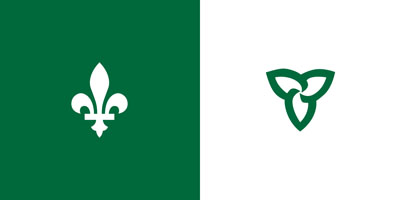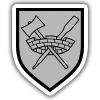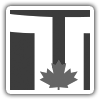Ontario, Canada
Flag
The flag of Ontario was adopted by the Legislature of the Province of Ontario in 1965. Ontario's flag closely resembles the Canadian Red Ensign. The Royal Union Flag occupies the first quarter, while the shield of arms of Ontario is charged on the fly half of the flag. The shield displays the cross of St. George and a sprig of three maple leaves.
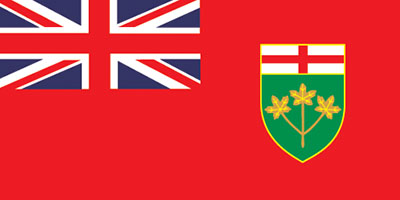
Other Provincial Symbols
- Floral Emblem: White Trillium
- Tartan: Tartan of the Province of Ontario
- Tree: Eastern White Pine
- Bird: Common Loon
- Gemstone: Amethyst
- Colours: Green and Yellow
Coat of Arms
Ontario was granted its coat of arms by Queen Victoria in 1868. The arms were augmented with a crest, supporters and motto by King Edward VII in 1909.
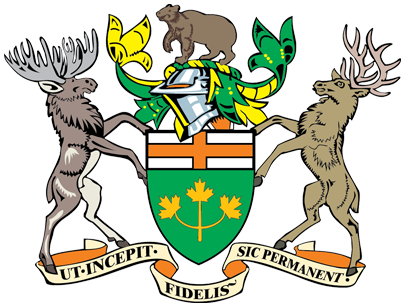
The red Cross of St. George, symbolic of England, appears in the upper third of the shield. The lower portion of the shield features three golden maple leaves, emblematic of Canada, on a green background.
The shield is supported by a moose and a Canadian deer; a black bear appears on the crest above the shield.

Origin of the Name
The word Ontario comes from the Iroquois word "kanadario," meaning "sparkling" water. The province is aptly named: lakes and rivers make up one-fifth of its area. In 1641, "Ontario" described the land along the north shore of the easternmost part of the Great Lakes. Later, the southern part of the province was referred to as "Old Ontario." The name "Ontario" was adapted for the new era that began in 1867, when the area became a province.

History
Ontario was first inhabited by the Algonquian and Iroquoian-speaking nations. The most important Algonquian nation in Ontario was the Ojibwa, which lived in northern Ontario. There were two major Iroquoian confederacies: the Iroquois and the Huron. The Five Nations of the Iroquois (Seneca, Oneida, Onondaga, Cayuga and Mohawk) lived near Lake Ontario and Lake Erie. The Huron nation inhabited the area near Lake Simcoe.
These nations were highly developed politically and culturally by the time the Europeans penetrated the area. In 1610, Henry Hudson became the first European to set foot in Ontario. Samuel de Champlain and Étienne Brûlé first established contact with the First Nations of Southern Ontario in 1613.
By 1774, the British controlled what is now Southern Ontario, then part of the Province of Quebec. After the American Revolution, the great influx of Loyalists to this region led to the creation of a new province. The Constitutional Act of 1791, which split the province in two, renamed the area Upper Canada. Although French-Canadians were and remain a significant proportion of Ontario's population, the great influx of Loyalists after the American Revolution helped force the separation.
Accustomed to autonomy in the American colonies, the Loyalists demanded changes to their new homeland. Rebellions against undemocratic government in 1837, in both Upper and Lower Canada, prompted the British to send Lord Durham to report on the troubles.
As a result of Durham's recommendations, the Act of Union of 1840 joined Upper and Lower Canada once again, this time as the Province of Canada. Although a more democratic and responsible government resulted, the union was not a success: Canada East and Canada West continued to be two distinct regions. They entered the confederation conferences of 1864 as though they were separate, and they became different provinces - Ontario and Quebec - at Confederation in 1867.
Ontario is the second largest and the most populous province of Canada. At Confederation, the province was little larger than present-day southern Ontario. Bitter border disputes with Manitoba over the area north of Lake Superior ended in 1889, when it became part of Ontario. The rest of Northern Ontario was annexed in 1912 when Ontario expanded to its current size.
Civic Flags
Ottawa, Ontario


Toronto, Ontario
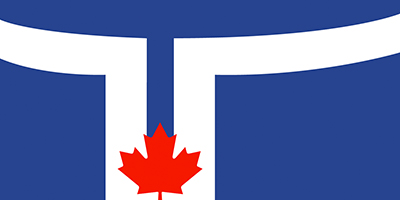

The flag of Toronto was adopted in 1974 after the city called for design submissions from the public. After the city amalgamated in 1997, council wanted to modify the design. Changes were adopted in 1999 by the original designer of the flag to form the design we know today. White outlines of City Hall are featured on a blue field, representative of the letter "T" with a red 11-point maple leaf positioned near the bottom centre.
Kingston, Ontario
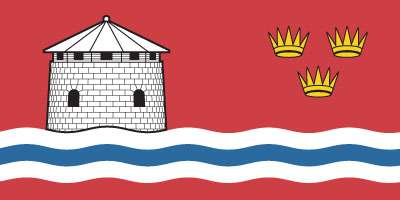

The Kingston flag features a Martello tower with three antique gold crowns in the upper fly over blue and white waves on a red field. The Martello tower is a unique feature of Kingston’s waterfront. It symbolizes strength and firmness of resolve and represents Kingston’s extensive military history. The three golden antique Crowns represent the three partner municipalities (the former Township of Kingston, the former City of Kingston and the former Township of Pittsburgh) which amalgamated in 1998 to form the new City of Kingston. The blue and white waves represent the confluence of three bodies of water in Kingston, Lake Ontario, the St. Lawrence River and the Cataraqui River/Rideau Canal system. The red field represents one of the two national colours of Canada.
Franco-Ontarian Flag
